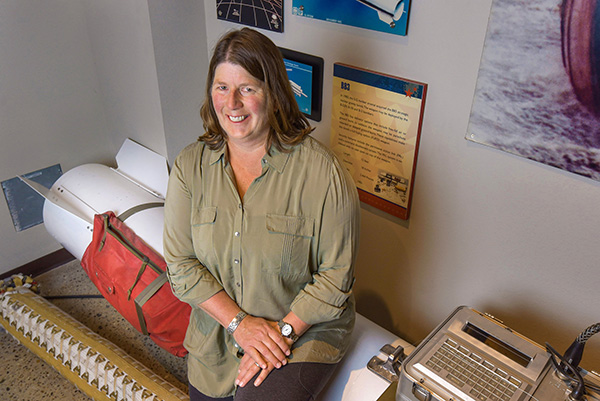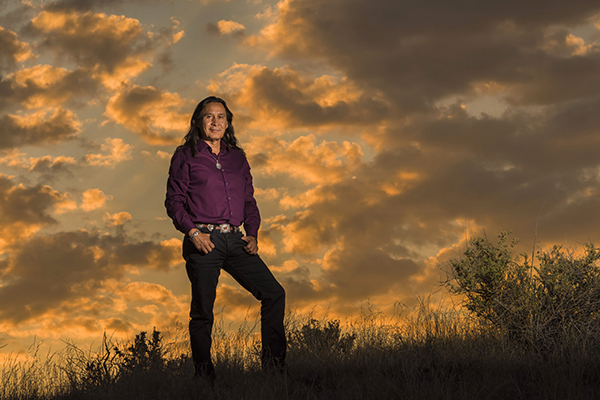
Sandia researcher Ginger Hernandez and Tribal Government Program Manager Laurence Brown have been honored by the American Indian Science and Engineering Society, AISES, for their career accomplishments. Ginger is the recipient of the AISES Technical Excellence Award and Laurence has received the Government Partner Service Award.
According to the AISES website, the Technical Excellence award winner is deemed to have made a significant contribution to science, engineering, or technology by having designed, developed, managed, or assisted in the development of a product, service, system, or intellectual property. Ginger is a PhD chemist who assesses emerging technologies for the Department of Energy.
The Government Partner Service Award “is not lightly bestowed,” according to the notification sent to Laurence informing him of the honor. “This award is a symbol of our appreciation for your hard work and contributions to the mission of AISES. We are humbled by your passion, service, and commitment to provide opportunities for Natives in STEM.”
Ginger Hernandez

Ginger earned a doctorate in inorganic chemistry from Texas Tech University after receiving her undergraduate degree at the University of Central Florida. From 1998-2010, she taught chemistry part-time at Central New Mexico Community College while also working full-time at Sandia. As a volunteer with the Dream Catchers Science program, she taught concepts of physical science by making and analyzing peanut brittle and building flutes.
Ginger came to Sandia in 1994 and spent the first six years of her career managing a materials characterization laboratory. In 2000, she transferred to the firing set capacitor group. “During that time, I also worked on a number of projects that supported a critical national security program for an external government customer,” she says. “That experience sparked my interest in Sandia’s work that provides data analysis and assessment to various government agencies. I wanted to be a part of that group and in the fall of 2009, I saw my opportunity — a posting for a technical analyst. Shortly after joining the Technical Assessments department, I became a team lead over a group of analysts who address evolving technical capabilities in a particularly unstable and dangerous region of the world. This is where I work today.”
Ginger, whose ancestry is of mixed Anglo and Cherokee background, says that as a child she didn’t have much exposure to her Native heritage.
“My grandparents struggled with their Cherokee identity because they grew up in a time when they were afraid of being identified as native. My Granny, who has significant Cherokee blood from both her mother and her father, played down — or sometimes outright denied — her heritage. As an adult, I’m trying to piece together who I am and how I fit into my Native community.”
Ginger says she is “incredibly honored” to be chosen for the AISES award. “But more so, I’m grateful to learn about the AISES community and begin to interact with them,” she says. “I look forward to getting more involved in helping students succeed in STEM. At the 2017 national AISES conference, I learned about many resources to help encourage and develop students in STEM career paths. I wish I had known about AISES when I was in college; I could have used their support.”
Ginger has words of advice and encouragement for students interested in working in the technical arena. “Getting a STEM education can be tough and overwhelming at times, but hang in there,” she says. “Never give up. Surround yourself with positive and encouraging people. Distance yourself from toxic influences. Your efforts will be well worth it because a STEM education will provide you with endless opportunities to earn a good living doing interesting and meaningful work.”
Laurence Brown

Laurence came to Sandia in 1989. Prior to that he worked for IBM for three years in Tucson after earning his BS degree in chemical engineering from New Mexico State University.
“I came to Sandia through the One Year On Campus program and went to Stanford for my MS in materials science and engineering,” he says.
Laurence’s first job at Sandia was in the thin film and brazing department. After a one-year Entrepreneurial Leave of Absence in 1995, he returned to the same department working on cooperative research and development agreements that intersected organizations across the Labs. Since 2002, he has been with Sandia’s Government Relations organization, focusing primarily on tribal government relations and tribal energy development.
Laurence became involved with AISES in 1986 while at IBM, became a Sequoyah Fellow (lifetime member) in 1989, and continued his very active AISES involvement at Sandia.
“I was instrumental as one of the founding members, developing charters and bylaws, of the first AISES professional chapter, the New Mexico Chapter, in 1991,” he says.
Laurence served on the AISES board of directors in the mid-1990s and continued his involvement afterward as active member of the AISES Corporate Advisory Council, often along with a Sandia executive champion. He has held his current national leadership role with the AISES STEM organization, as chair or co-chair, since about 2009.
While on the Corporate Advisory Council, Laurence was instrumental in developing the AISES Professional Awards program that began in 2004. Since that time, Sandia has had eight AISES Professional Award winners.
“AISES has been an important part of my profession development and the network of student and professional contacts contributes to the success of my Tribal Relations work at Sandia,” Laurence says. “AISES has been and continues to be the only game in town for diversifying our talent pool with top American Indian and Alaskan Natives in STEM.
“The AISES Government Partner Service Award means a lot to me with the recognition at the national conference that celebrated the 40th Anniversary of AISES.”